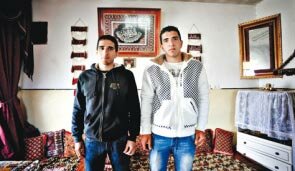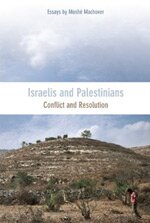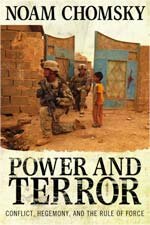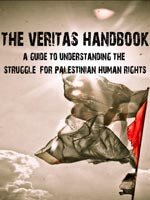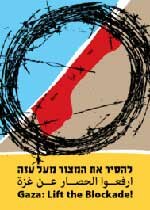Haaretz: “An increasing number of complaints of abuse during the interrogation of Palestinians from the Hebron area can apparently be traced to a computer program that grades police performance. An investigative report on the digitization of evil.”
IOA Editor: This important report shows how the Israeli Occupation authorities combine sophisticated performance management techniques, taken from the American corporate world, with traditional interrogation/torture techniques – resulting in sheer horror for their Palestinians subjects.
By Shay Fogelman, Haaretz – 9 July 2010
www.haaretz.com/magazine/friday-supplement/winning-on-points-1.300971
An increasing number of complaints of abuse during the interrogation of Palestinians from the Hebron area can apparently be traced to a computer program that grades police performance. An investigative report on the digitization of evil.
At 3:30 A.M. on July 12, 2009, say Hamed and Ahad Jeredath from the village of Sa’ir near Hebron, Israeli soldiers entered their home and arrested them. The two brothers, aged 22 and 19, respectively, say that when they got outside they were handcuffed behind their backs with plastic handcuffs and blindfolded. They were taken in a military vehicle to a place they could not see and then by Jeep to the Etzion incarceration facility in the Etzion Bloc of settlements south of Bethlehem.
It was early in the morning when they arrived. They were, they say, examined – separately – by a uniformed medic or physician with an interpreter on hand. Hamed was then made to stand on his feet for some hours, facing a mobile home. Afterward, a soldier took him to a small room. Waiting for him was someone who said he was an interrogator from the Mukhabarat (intelligence, in Arabic ), a term that usually refers to the Shin Bet security agency. The interrogator asked Hamed about his involvement in a few cases of stone throwing. Hamed denied the charges. The interrogator hit him and promised him that this day he would confess, even against his will.
According to Hamed, the interrogator then covered his head with a long, thick sack, which reached down to his waist. “It was suffocating and it stank,” Hamed says. “You could hardly breathe in the sack.”
The younger brother, Ahad, relates that an interrogator who said his name was “Amram” or “Amran” covered his head with a sack that reached to his stomach, while he was still handcuffed and blindfolded. In this situation, he says, the interrogator pummeled him from all sides, mainly on his head, shoulders, chest and legs. Ahad says he threw up in the sack under the force of the blows, but that the interrogator just hit him harder.
Hamed recalls that at a certain stage his interrogator left the room; after a time a new one entered. (He identified each new interrogator by voice and by the names they used. To the best of his recollection, he had three interrogators: Amran, Daoud and someone whose name sounded like Jendel, or something similar. ) The new interrogator, he says, grabbed him by the neck and told him that if he confessed he would persuade the previous interrogator not to hit him anymore. Hamed replied that he had nothing to do with stone throwing. In reaction, the interrogator kicked him in his right leg and then in the stomach and back.
At this stage, the second interrogator was replaced by a third man, who removed the sack from Hamed’s head and asked him, “Which leg would you like to have broken?” He started to kick him in both legs. Hamed fell to the ground. He got up and the interrogator renewed the kicking until he fell again.
Hamed, now barely able to walk, was taken to another room. The interrogator who led him there said he would now bring in his brother, Ahad. He threatened to beat them both, administer electric shocks and hang them by their feet. He kicked Hamed viciously in his left leg. Hamed fell to the ground. Hamed says the interrogator picked him up and continued to kick him in his left leg.
Ahad says he heard his older brother’s screams. The interrogator now turned to him, grabbed his head and rammed it into the door. Ahad almost passed out from the pain. Hamed, who was blindfolded, realized that Ahad was also in the room when he heard his screams of agony. An interrogator asked Hamed, “Which of you will confess, you or your brother?” He kicked Hamed in the leg again, this time harder. Hamed collapsed. He tried to get up but could not. The interrogator, he says, put his foot on his head and pressed hard.
According to Ahad, “Amran” then removed the sack from his head and took off his blindfold. He was appalled by what he saw: his older brother lay on the floor, handcuffed and blindfolded, writhing in pain. The interrogator told Hamed that if he confessed, his younger brother would be released. But Ahad, seeing his brother’s agony, says he decided to confess in order to put a stop to the torture his brother was undergoing. Hamed was released after three days without being charged. Ahad was indicted, and after 38 days in detention was sentenced to time served and a fine, and released. A comparison of the two medical checks he underwent – immediately upon his detention and a week later – shows a new contusion on his right knee.
Rumors and programs
For the past few months, human rights groups that are active in the territories have reported an alarming rise in the number of complaints filed by Palestinians who say they are being subjected to violence and torture in interrogations. The testimonies describe appalling beatings, humiliations and threats, along with the use of techniques – a sack over the head, binding in painful postures and violent shaking – which were declared illegal by the High Court of Justice in 1999.
Human rights activists and Palestinians alike were at a loss to explain the sudden increase in the use of these methods. Maybe it was a policy shift, the reflection of a new political reality, or simply a result of the arrival of new officials in key positions. Rumors in a few Palestinian villages held that a senior official in the defense establishment whose car had been hit by a stone was out for revenge. The possibility that a few sadistic interrogators had joined the security agency was not ruled out.
However, a lengthy journalistic investigation has found that the reason is not the banality of evil, but its digitization. According to the testimony of a number of police officers, “This whole series of abuses may be due to nothing more than a desire to improve the statistical results in a new program.” They are referring to a computer program called Menahel (Hebrew for manager ). For the past few years, data on police activity to combat crime have been fed into the program, which awards points to the police stations and their chiefs. The points are taken into account in every decision about promotion.
Throughout the past decade, even after the High Court’s 1999 decision, human rights organizations received complaints about the use of violence and other prohibited methods in Shin Bet interrogations. According to the Public Committee against Torture in Israel, since 2001 more than 600 such complaints have been submitted to the office of the attorney general. Disciplinary action was taken against interrogators in only four cases. The official response to a small number of additional complaints was that the interrogation procedures had been changed. All the other complaints were rejected on various grounds, mainly that the complaints were incorrect, had been submitted late or that the interrogators had acted with justification. The fact that it usually took six months to get a response to the complaints is further evidence of officialdom’s attitude.
Brutal methods
Lately, however, reports about excessive violence in interrogations have increased substantially. From dozens of testimonies collected by the various rights groups, a picture emerges of more brutal methods of interrogation than in the past, particularly in cases of young people from villages in the Hebron area accused of throwing stones at Israeli vehicles. Most of them have been interrogated at the Etzion police facility, which is said also to be used by the Shin Bet. Many detainees said they were told that they had been arrested in the wake of incriminating testimony by others. According to Attorney Bana Shoughry-Badarne, head of the legal department of the Committee against Torture, more than 70 testimonies fitting this profile have been received since last summer.
M., 24, from a village near Hebron, was arrested in similar circumstances five weeks after being discharged from a hospital, after undergoing a stomach operation. He noted this fact on a form he signed when he underwent a medical examination at the time of his detention. The examining doctor, he says, saw the surgical scar. M. was interrogated in the same building as the Jeredath brothers. After denying his involvement in stone throwing, he says, he was punched in the face by the interrogator and kicked in the stomach at the place where he underwent surgery. He fell to the ground and shouted, “I had an operation, don’t hit me.” The interrogator, he says, “picked me up and grabbed me by the neck and said, ‘You cry like girls, we’ve seen a lot of people like you.’ I felt that I was hit many times.”
M. says two other people, whose faces he did not see, also took part in beating him. “I was really worked over,” he told lawyers from the Prisoners’ Club in Hebron. “The three of them would leave me alone for a time and then start beating me again in the same way – kicking, punching and pushing me against the wall. I fell down dozens of times. I screamed from the pain. The interrogators wanted me to confess to throwing stones. They also asked me to tell them about other people who threw stones. I kept telling them I didn’t throw stones and didn’t know anything. They kept attacking me. Later, they said they would only stop hitting me if I confessed, I was forced to tell them, ‘If you want me to confess, I will confess only so you will stop hitting me.’ But despite that, the interrogators went on beating me.”
His interrogation lasted for more than two hours, he estimates, in which he was pummeled relentlessly. “At the end of the interrogation I fell to the ground, exhausted and unable to move. My whole body was in pain and I could not stand up. The interrogators ordered me to get up, but I couldn’t. Two of them dragged me by the arms and sat me down on a chair. A few minutes later, one of them removed the blindfold and cut the handcuffs. I saw that I was in a police station and a police interrogator was standing opposite me. He used a tape recorder to take down what I said. He asked me if I threw stones. I denied it and told the interrogator that I was beaten badly during the interrogation.”
A few days later, while still in detention, the pain in his testicles and stomach, which had begun after the interrogation, increased. He now suffered from powerful headaches, shortness of breath and vomiting. M. relates that it was only following the protests of other prisoners that he was sent to a hospital in Jerusalem. Since being released, he says, he has had to visit the hospital for treatment almost every day and may have to undergo more surgery. Incidentally, he was tried, convicted and sentenced to a fine.
Many other Palestinian prisoners have testified in recent months about being subjected to violent interrogations at the Etzion facility. In almost every case, the torture ended when they confessed. A few relate that their torturers were dressed in civilian garb, and that after stating their willingness to confess they were formally interrogated by a uniformed police officer. The names of several interrogators recurred consistently in the complaints, notably “Daoud” and “Amran” (or “Amram” ); another name often mentioned was “Abu Zadi.”
Facebook lineup
Several Israeli human rights organizations have submitted the testimonies they collected to the office of the attorney general. The procedure is that such allegations are examined by an investigator of complaints of abuse in Shin Bet interrogations. If warranted, in the investigator’s opinion, he recommends that the attorney general refer the case to the Justice Ministry’s department for the investigation of police officers. Of the hundreds of complaints referred to the investigator over the last decade, not one was recommended for further examination, and the attorney general approved every negative recommendation, without exception. Dozens of cases documented in recent months received the same treatment.
Both the investigator of complaints and the attorney general maintain forcefully that no Shin Bet personnel were involved in the violent interrogations. On the other hand, the victims’ testimonies are inconsistent with procedures for police interrogations. For example, the interrogators wore civilian clothes and did not wear ID badges; like Shin Bet interrogators, they used a variety of names and aliases; and the interrogations were not filmed, as required by law in police investigations of serious crimes and in interrogations that are conducted in one language (Arabic, in this case ) and transcribed in a different one (Hebrew ). Nor were the parents or lawyers of juveniles summoned, as required under a new law.
Beyond the fact that the young people were arrested by soldiers and that some of them were tried in military courts in the territories, no one knew anything about the violent interrogators. At this stage, human rights activists began to think that the interrogators might, after all, be police officers. The Committee against Torture and B’Tselem, the Israeli Information Center for Human Rights in the Occupied Territories, apprised the Justice Ministry’s investigation department of their suspicions, but received only negative replies.
A few methods of discovering the identity of the suspected torturers were examined in recent months. One of them was to look back at judgments handed down against police officers from the Hebron station who were suspected or accused of committing similar acts of violence in the past. The names of a number of police officers who might be involved in the violent interrogations were arrived at by this method.
Of these policemen, only one has a Facebook page. In consultation with criminal lawyers, a police-type “lineup” was constructed consisting of eight photographs, one of them taken from the police officer’s Facebook page. With the cooperation of the Committee against Torture and the Hebron-based Prisoners’ Club, two of the detainees were asked to look at the photographs. Both of them – separately – firmly and unequivocally identified one of the photographs as the person who called himself “Amram” or “Amran.”
In a telephone conversation, the police officer confirmed that he used the alias “Amran” but refused to comment on the allegations against him. (His real name is not being revealed here, as police authorities claim that its publication might endanger his life. ) In the wake of these discoveries, the Justice Ministry spokesman was asked about the complaint filed by M. and the Jeredath brothers. The reply: “The complaint of Hamed and Ahad Jeredath was received by the investigation department and an inquiry was launched in the course of which the material relating to their arrest and interrogation was collected and examined. Among other things, in the investigation, substantial contradictions arose in the complainants’ accounts concerning subjects relevant to the root of the complaint, as a result of which it was impossible to rely on their statements. Moreover, the medical documentation produced by one of the complainants did not support the description of the complaint. At the conclusion of the investigation and taking note of all the evidence, the decision was made to close the case on grounds of no guilt.” The findings in the case of M.’s complaint were identical.
A police officer who is knowledgeable about the details of the investigation says that even if there is a basis for the complaints against “Amran,” he is “just the doorkeeper.” The source adds – and is backed up by others in the Hebron police force – that “Amran” does not possess a sadistic character or behave in a way that goes beyond the existing norm. “There are interrogators at the station who are considered even more violent,” the officer adds.
According to the officer, “this is only the tip of the iceberg” of a much broader phenomenon, which is far more consequential and encompasses all police branches and districts. “The Menahel program sent just about everyone into a tailspin,” he says. “Almost every station is preoccupied with the data, in an effort to crack the method that will give them a higher points rating. Once the present commissioner made the program the central factor in assessing the performance of police officers, the whole system went into a loop, in a way completely unrelated to the roles and missions of the police.”
Police publicity shows that the Menahel project was introduced before the appointment of the current police commissioner, David Cohen. However, according to some senior officers, Cohen is one of the program’s great advocates. The program, as described by police officers, weighs the activities of police stations according to fixed parameters. Its goal, as declared in police documents, is “to create a managerial tool that will be effective, qualitative, useful, problem-oriented, result-oriented and creative, to enable an objective organizational assessment to be carried out.” The slogan: “What is not measured is not managed, and what is not managed cannot be improved.”
All police activity is fed into the system, which is intended to help formulate investigative moves and upgrade the station’s performance. At the end of the day, each station also gets points for its achievements. Service to citizens, for example, accounts for 10 percent of the overall grade. Meeting the goals is worth 30 percent, and so on. “This method,” says a former senior police officer, “leads officers of all ranks to sometimes classify certain offenses as less serious, in order to come up with data showing a decrease in the level of crime. After all, there are plenty of possible charges to choose from. Robbery, for example, can be classified as assault with the aim of theft, which is a far lesser charge.”
Higher grade
According to the testimonies of six police officers, similar phenomena, at varying levels of seriousness, exist in many police stations, but are more prevalent in areas where the population is weak, such as in Hebron. An examination of the system and the weighing of the grade assigned to the different stations shows that two factors make it extremely attractive to arrest young Palestinians on suspicion of stone throwing – sometimes far more than dealing with other criminal offenses. First, the capture of stone throwers is usually defined as an “offense of exposure” – that is, no complaint has been filed, but the police themselves initiate the arrest and interrogation of suspects to extract a confession.
Handling such offenses boosts a station’s grade by 4.2 percent. Second, confessions by young people give the officers of the Hebron station more points, which under certain circumstances can reach 7 percent. An additional 20 percent is given if the arrest and the confession fall under the category of meeting the district’s goal, as was true of a number of the cases here.
A police officer who is knowledgeable about the activity of the stations in the West Bank, relates that this is not the only type of offense the Hebron station has focused on lately. “The commissioner declares that we have to fight knife-wielding by juveniles, for example,” he says. “He does not say exactly how this is to be done, so the district commander sends his policemen to search in cars for sharp files or box cutters. Naturally, every knife can have many uses that are not necessarily criminal, but every box cutter found in a vehicle can lead to a charge sheet. So why not?”
The officer offers another example: “Policemen stop a Palestinian passerby who is carrying a mobile phone and ask to see a receipt for its purchase. No one has such a receipt, least of all Palestinians in the territories. If they don’t show a receipt, they can be arrested on a charge of being in possession of stolen property. There have been quite a few cases like that in Hebron and in other police districts in the territories.”
In the view of this source, this method of work is detrimental to the deterrent capability and routine functioning of the police. “In Hebron, for example,” he says, “there is one patrol van, and on some shifts, two. For one of them to deal with a stupid thing like that takes at least an hour and a half. The Jews are angry, because there is no police presence, and the Arabs are furious because there can be lifelong consequences for a kid who gets a criminal record for some meaningless thing. Even if he’s acquitted in a trial, the criminal record might in the future prevent his being allowed into Israel for medical treatment, for example.” Indeed, the officer says, since the chief of the Hebron District, Yitzhak Rahamim, took over about a year ago, the station seems to be preoccupied exclusively with running the Menahel program.” Amazingly, the arrival of Commander Rahamim coincides with the period in which the number of testimonies about abuse began to rise in the Hebron area. According to the source, “Arresting a Palestinian youth and charging him with stone throwing gets a high grade in the program, so it’s possible that the policemen in the station found an easy way to earn high credit for their activity, irrespective of the suspect’s guilt – and, naturally, also without any connection to the police battle against crime.”
Another issue raised by the officer posits more questions about the propriety of the interrogations conducted by the station. “Amran” is from police intelligence, as is another officer who was identified in the Haaretz investigation as allegedly having taken part in several violent interrogations. But intelligence personnel do not belong in the interrogation room; the police rigorously separate intelligence questioning and interrogations. The testimony given under each type of questioning possesses a completely different legal status.
It’s important to note that in the Menahel program, a conviction is not necessary to get points – it’s enough to file an indictment. “Investigations of stone throwing,” say a number of policemen, “are considered far simpler and easier than seizing knives or finding suspected stolen phones. The police don’t even have to leave the station in order to get the points. They transmit a list of suspects to the army, which makes the arrest for them and takes the suspects to the Etzion facility. All the police have to do is to extract a confession.” And it turns out that to earn a high mark from the computer, they are willing to go a long way to do that. W
No such thing?
Gil Elhadad, spokesman for the Samaria and Judea (known by the acronym Shai ) police district, rejects allegations of the use of violence and impermissible means in interrogations by the Hebron station. “It is impossible to point to any such phenomenon or tendency,” he says. “We transmit every [complaint] by interrogees that violence was used against them to the Justice Ministry’s department for the investigation of police officers. According to internal procedures, police intelligence personnel in the Shai District are permitted to question suspects without identifying themselves by name and are allowed to work in civilian clothes. Every such questioning session is documented in the investigative file, if not by means of recording then at least in the memorandum, which the officer signs with his full name, as required by the procedures.”
According to Elhadad, “There is no connection between the allegations made in the article and the Menahel program. The program is indeed very significant in the work of the police in the different districts, but the allegations about it stem from poor public relations and a lack of understanding about the factors it weighs.”
As for claims that some police officers have turned the program into a tool that affects operational activity, he replies, “The Menahel is not the be-all and end-all. It is a tool aimed at meeting the goals of the organization, and it’s a supportive tool in the hands of the station chief.”
The IDF Spokesman stated: “The IDF works in coordination and cooperation with the Israel Police, the Samaria and Judea District and all the security forces to provide security for the inhabitants of Israel and the Judea and Samaria region against a variety of threats, some of which are criminal. Every arrest that is made undergoes a review process in the IDF and coordination with the Israel Police, based on professional priorities. Participation in violent, illegal disturbances constitutes grounds for arrest if needed to implement enforcement of the law and the prevention of violent and illegal actions against the security forces, civilians and public property.
“The Military Police Corps is responsible for holding the detainees in legal custody in the Etzion facility and for its routine maintenance. However, interrogation of detainees is conducted by the Shin Bet or by the Israel Police, without the intervention of the Military Police. If detainees complain to Military Police personnel about violence in interrogations or during their arrest, a report is made to the relevant authorities for the continued examination of the allegations.”
A spokesperson for B’Tselem stated: “The exposure of the prolonged and systematic abuse of detainees in the Etzion facility warrants a sharp and immediate systemic response, which will include a thorough investigation of all the cases and meting out full justice to everyone involved. Above all, measures must be taken against the abusive police interrogators. In addition, an inquiry must be made into the responsibility of the security and civilian personnel who work at the facility and knew about the grave offenses being perpetrated in the facility but chose not to report them, but rather to cover them up or collude in them. These personnel include, among others, medics and physicians who must be suspected of knowing about the harm done to the detainees but not reporting it, contrary to their legal and moral duty.
“Finally, the responsibility of the commanding officers must be examined, including the orders that were given to all those who came into contact with the detainees about how to treat them and the supervisory mechanisms that were established to ensure that these directives are in fact carried out. The confessions which the suspects made to the interrogators must also be reexamined. Should it turn out that they were obtained by means of abuse, everyone who was convicted on the basis of these confessions must be released and compensated for the infringement of his rights.”
